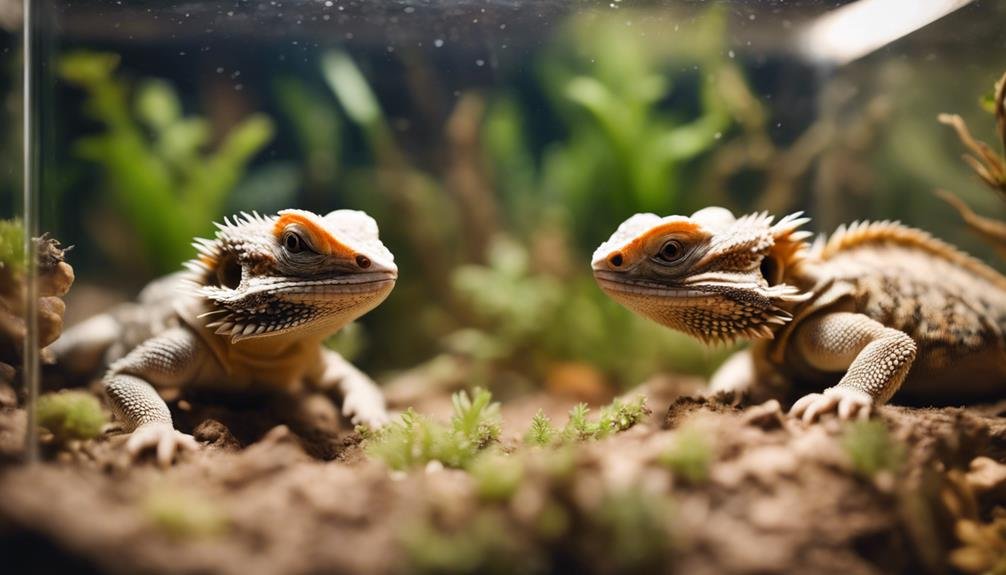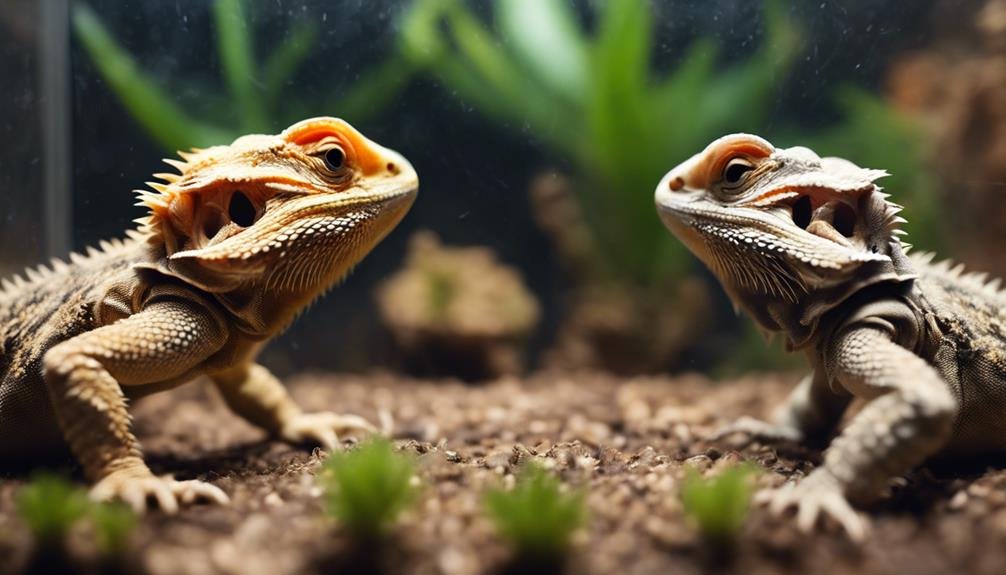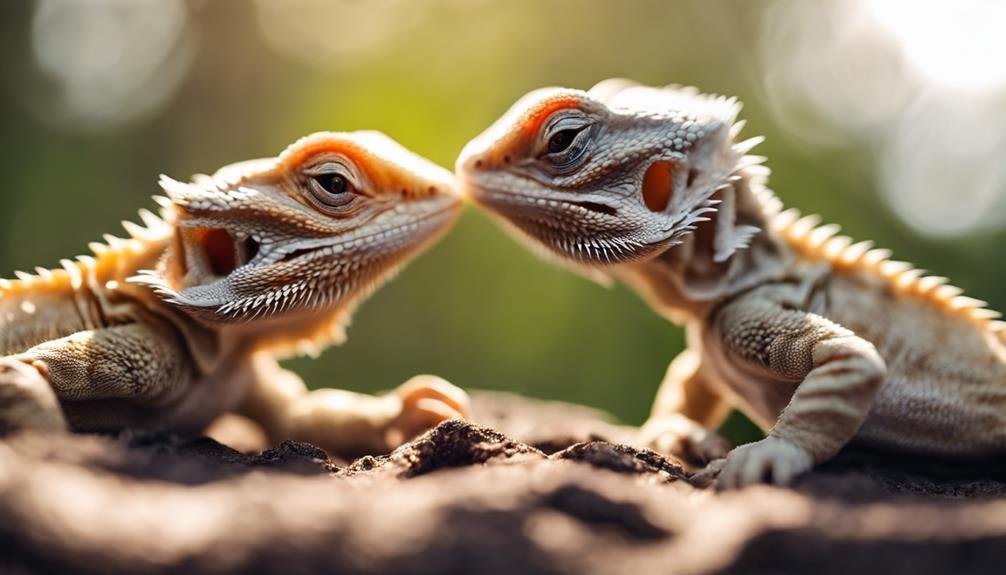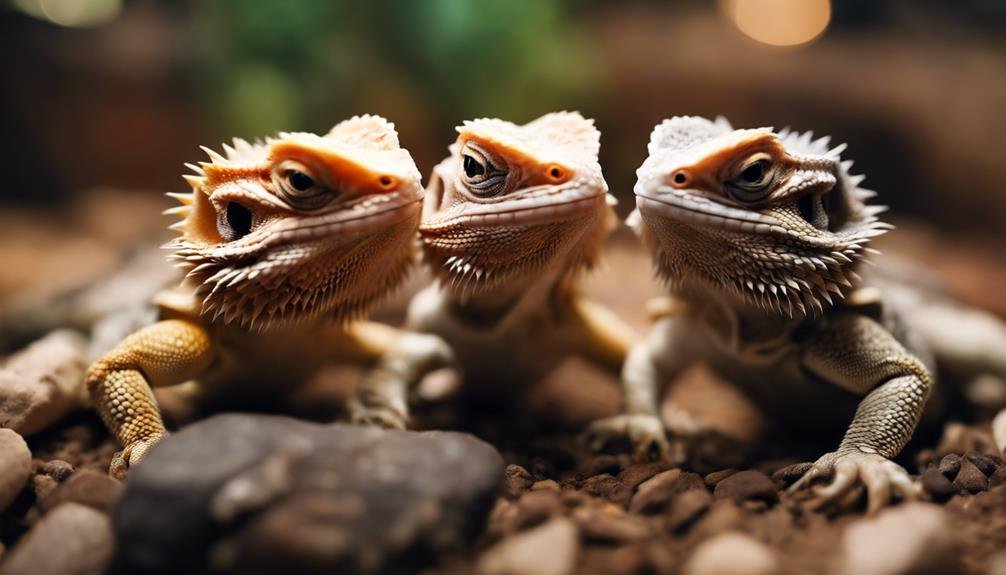You might wonder if you can house two baby bearded dragons together without sparking a mini-warfare in their terrarium. It's a delicate balance, indeed. Their interactions can swing wildly from peaceful cohabitation to fierce rivalry, depending on several factors you'll need to navigate carefully. From ensuring a proper introduction in neutral territory to recognizing the early signs of stress or aggression, there's a lot to contemplate. But why is it so critical to monitor their relationship closely, and what steps can you take to foster a harmonious environment? Let's explore the intricacies of bearded dragon friendships and enmities, uncovering what lies beneath their seemingly tranquil existence.
Key Takeaways
- Putting two baby bearded dragons together risks aggression and territorial behavior, potentially leading to injuries.
- Gradual introduction in a neutral space with supervision is crucial for reducing stress and preventing fights.
- Separate enclosures are recommended to give each dragon adequate space, preventing competition for resources and reducing aggression.
- Monitoring their interactions closely during feeding and cohabitation helps identify signs of aggression or compatibility.
- Creating a positive environment with individual hides and feeding practices can foster camaraderie, but vigilance is necessary to prevent conflicts.
Understanding Bearded Dragon Behavior
To guarantee the health and safety of baby bearded dragons, it's paramount to understand their territorial and aggressive tendencies. Even at a young age, these reptiles can display behavior that might seem surprising given their size. They're naturally inclined to establish dominance, which can lead to aggressive interactions such as biting. This isn't just limited to minor nips; baby bearded dragons may bite off tails, toes, or cause other severe injuries to each other if they're housed too closely without proper space to claim as their own.
It's a misconception that their young age makes them less prone to fighting. In reality, even baby bearded dragons can engage in battles that may lead to injuries or, in extreme cases, fatalities. This aggression stems from their territorial nature and is often exacerbated when they're placed in an environment that doesn't meet their spatial needs.
Moreover, housing baby dragons together without understanding the risks can lead to stress, which negatively impacts their health and well-being. It can also unintentionally promote overbreeding, further complicating their care. Recognizing these signs of aggression and territorial behavior early on is paramount to prevent harm and establish a safe, stress-free environment for baby bearded dragons.
The Importance of Proper Introduction
Understanding how to properly introduce baby bearded dragons is essential for their well-being and to prevent aggressive encounters. The process involves gradual acclimation to each other's presence, which means you can't just place them together and hope for the best.
Starting off, introducing your baby dragons in a neutral territory is key. This strategy helps avoid territorial disputes that are common when a new dragon is introduced into an established dragon's space.
It's also vital to supervise their interactions closely. This supervision allows you to observe their body language and behavior, ensuring that both dragons are comfortable and that no aggressive behavior is emerging. If you notice any signs of stress or aggression, it's a clear indicator that the introduction is moving too fast, and you'll need to slow down the process.
Rushing this process can lead to stress, aggression, and even potential injuries among your baby bearded dragons. Remember, building a positive relationship between them takes time and patience. By carefully monitoring their interactions and giving them the time they need to get used to each other, you're setting the stage for a harmonious cohabitation.
Creating a Suitable Environment


To guarantee the well-being of your baby bearded dragons, it's vital you set up their habitats with care.
You'll need to take into account ideal habitat conditions and the space and territory each dragon requires to thrive.
This approach helps prevent stress and aggression, safeguarding their health.
Optimal Habitat Conditions
Creating the ideal habitat for each baby bearded dragon is essential. Ensuring they have individual access to the proper heating, lighting, and space they need to thrive is crucial. Since baby bearded dragons are territorial and can exhibit aggressive behavior, especially between males and females, it's important to provide separate habitats. This prevents not only stress and potential injuries like missing toes, tails, or limbs but also avoids overbreeding issues. By giving each dragon its own space, you're safeguarding their health and well-being, allowing them to grow without the constant threat of aggression from a tankmate.
Space and Territory Needs
For your baby bearded dragons to thrive, they each need their own space that allows them to establish territories and avoid aggression. If you're considering whether to put them together, it's important to understand the importance of separate enclosures. This prevents competition for essential resources and reduces stress, injuries, or worse.
| Need | Benefits of Separate Spaces |
|---|---|
| Space to Grow | Avoids competition, promotes growth |
| Exploration | Reduces stress, encourages natural behavior |
| Resource Access | Prevents fighting over food and basking spots |
| Territory Establishment | Decreases aggressive behaviors, enhances well-being |
Creating individual environments for your baby dragons not only helps them develop properly but also greatly lowers the chance of conflicts, ensuring they can live happily and healthily.
Monitoring Their Interactions
Once you've placed baby bearded dragons together, it's crucial to keep an eye on them for any aggressive behavior or signs of stress.
You'll need to watch out for actions like tail whipping or head bobbing, which signal stress or attempts to establish dominance.
If you notice these behaviors, you must separate them quickly to avoid injuries.
Identifying Aggressive Behavior
To guarantee the safety of your baby bearded dragons, it's important to recognize the early signs of aggression, such as puffing up, head bobbing, and tail whipping, during their interactions. Aggressive behavior can quickly escalate, leading to fights, injuries, or even fatalities among baby dragons. Keeping a close eye on their interactions is vital to prevent harm and safeguard their well-being.
Here are three key points to remember:
- Aggressive behavior may be more subtle in baby dragons but can still have serious consequences.
- Understanding the signs of aggression and intervening when necessary is essential.
- Monitoring their interactions closely helps in preventing any harm to your baby bearded dragons.
Being vigilant about these behaviors will help maintain a safe and harmonious environment for your pets.
Signs of Stress
Understanding the signs of stress in your bearded dragons is vital for their well-being, as these can include behaviors like tail twitching and black bearding. When you're monitoring their interactions, lookout for signs that might indicate they're not comfortable with each other. You might see them puffing up, displaying aggression, or even hiding, which are clear indicators they're feeling stressed. Other behaviors, such as lack of appetite, glass surfing, and excessive basking, also suggest that they're under stress.
It's essential to keep an eye on these signs, as aggressive actions like biting, tail lashing, and body slamming can pose a real danger to their health. Rapid breathing, color changes, and submissive postures are additional signs that shouldn't be ignored. Remember, understanding and acting on these stress signals is key to ensuring their well-being.
Establishing Dominance
When you put two baby bearded dragons together, it's important to closely monitor their interactions to observe how dominance is established between them. Even at just a few months old, one dragon may try to assert itself over the other. This can be seen through:
- Head bobbing to show superiority.
- Arm waving as a sign of submission.
- Puffing up or standing taller to appear more dominant.
If one tries to bite or excessively bully the other, it's essential to intervene to prevent injuries or stress. Remember, while establishing dominance is natural, your goal is to make sure both dragons remain safe and healthy. Keep an eye out for these behaviors, especially in the early months, to help manage their relationship.
Feeding Together Safely
Feeding baby bearded dragons together necessitates vigilant observation to guarantee their safety and prevent any aggressive behavior. Even though group feeding can foster a sense of camaraderie among them, it's important to keep a close eye on their interactions. This close monitoring helps identify any signs of food aggression or territorial disputes early on, ensuring a peaceful mealtime.
By providing ample food for each dragon, you're minimizing the chances of competition that could lead to conflicts. It's a simple yet effective strategy to keep the peace during feeding sessions. Remember, enough food for everyone means there's no need to fight over resources.
Interestingly, feeding females together tends to work out smoother compared to males. The territorial nature of male bearded dragons often leads to tension, so it's generally best to feed them separately to avoid any unnecessary stress.
In essence, creating a positive feeding environment involves more than just throwing food into their habitat. It's about ensuring each baby bearded dragon gets their fair share in a calm, controlled setting. This approach not only helps them get used to each other's presence but also establishes a routine that promotes harmony rather than rivalry.
Recognizing Signs of Aggression


After ensuring a peaceful feeding environment, it's equally important to recognize signs of aggression in baby bearded dragons to maintain their safety. Recognizing signs of aggression early can prevent injuries or fatalities among your pets. Here are a few behaviors you should be on the lookout for:
- Physical and Vocal Indicators: Hissing, flaring of the beard, and aggressive posturing are unmistakable signals. These actions show that a bearded dragon feels threatened or is ready to assert dominance.
- Territorial Actions: A dominant dragon might block others from accessing food or prime basking spots, showing territorial behavior towards the enclosure's resources.
- Hostile Interactions: Tail twitching, head bobbing, and puffing up can precede chasing, biting, or attacking, which are direct forms of aggression.
If you observe any of these behaviors, it's a clear sign that the dragons aren't getting along and may need to be separated to avoid harm. Recognizing these signs of aggression is vital for the well-being of your baby bearded dragons, ensuring they grow up in a stress-free environment.
Providing Separate Spaces
To ensure the well-being of your baby bearded dragons, it's vital to provide each one with its own separate enclosure. Remember, housing baby dragons together can spark territorial disputes, leading to potential harm. By setting up separate housing, you're not only preventing aggression and injuries but also ensuring that each dragon has uninterrupted access to essential resources like food, water, and their much-needed basking spots.
It's important to understand that these solitary spaces help to reduce stress and competition among the young dragons. When they're not vying for the same resources, each baby dragon can thrive, grow, and develop in a healthier and safer environment tailored to its individual needs.
Encouraging Positive Relationships


How can you foster positive relationships between your baby bearded dragons? You might already know a thing or two about their care, but ensuring they get along takes a bit more insight. By creating a positive environment and carefully managing their interactions, you can encourage a peaceful coexistence.
- Feeding them together can create a positive association. When they eat in each other's presence without competition, it helps them see one another as companions rather than rivals. However, it's important to offer separate feeding dishes to minimize competition and guarantee each dragon gets its fair share.
- Providing ample space and hides in their enclosure is essential. This setup allows them to have their own territories and retreats, reducing stress and preventing territorial disputes. Remember, a cramped space is a recipe for conflict.
- Closely monitoring their interactions and introducing them gradually in a neutral space can greatly influence their relationship. This approach helps gauge their compatibility and reduces the likelihood of aggressive behavior from the get-go.
You already know the basics of caring for baby bearded dragons, but fostering a harmonious relationship between them requires attention to their interactions, space, and individual needs. By following these steps, you're setting the stage for a positive and peaceful cohabitation.
Is it Safe to House Two Baby Bearded Dragons Together for a Long, Healthy Life?
Many reptile keepers wonder about the secrets to long life for their pets, especially when it comes to housing baby bearded dragons together. While it can be tempting to keep them in the same habitat, experts advise against it for long-term health. Each dragon needs its space to thrive and avoid potential aggression issues.
Frequently Asked Questions
Can 2 Juvenile Bearded Dragons Live Together?
You shouldn't house two juvenile bearded dragons together. They're territorial and can show aggression, leading to injuries or worse. Space management is important here; each dragon needs its own area to prevent stress and fighting.
Even without considering friendships or enemies, the risks of overbreeding and constant stress are too high. For their well-being, it's necessary to keep them separated. This way, you'll guarantee both your bearded dragons stay healthy and happy.
Can I Put a Baby Bearded Dragon With an Older One?
You shouldn't put a baby bearded dragon with an older one due to age dynamics. The size and age difference can lead to stress, aggression, and even injury. Older dragons may see the younger ones as competition, risking the baby's safety.
It's important to keep them in separate enclosures to guarantee both their well-being. Remember, the vulnerability of baby dragons makes them unable to defend against more dominant, older dragons.
Would Two Bearded Dragons Fight?
You're right to wonder if two bearded dragons would fight. Given their territorial behavior, it's highly likely they'd clash if housed together.
Even as babies, they can become aggressive, potentially leading to serious injuries like lost toes or even limbs.
It's essential to understand that their instinct to dominate can turn deadly, so keeping them separate is your best bet to avoid any harm.
Always prioritize their safety and well-being.
Can Bearded Dragons Become Friends?
You might wonder if bearded dragons can become friends, considering their social dynamics. Unfortunately, they're naturally solitary and don't seek friendship with each other.
When you put two together, especially as babies, you're more likely to see aggression rather than companionship. Their instinct is to be territorial, not social, leading to potential fights rather than forming bonds.
Conclusion
To sum up, you can indeed put two baby bearded dragons together, fostering friendships rather than enemies with careful management. Remember to introduce them properly in a neutral area, create a comfortable environment, and closely monitor their interactions.
Feed them safely to avoid competition, watch for any signs of aggression, and provide separate spaces if needed. By encouraging positive relationships from the start, you're setting up your bearded dragons for a harmonious life side by side.


